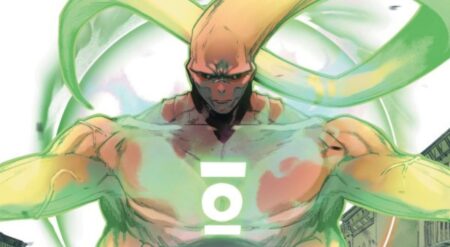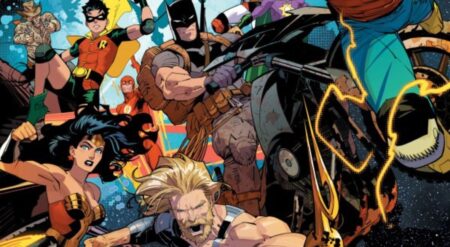
Justice League #61 is published by DC Comics. The first story is written by Brian Michael Bendis, with art by David Marquez. The colour artist is Tamra Bonvillain, and the letters are from Josh Reed. The second story is about the Justice League Dark, written by Ram V, and the artist is Xermanico. Colours by Romulo Fajardo Jr. and the letterer is Rob Leigh.
The Justice League had twice battled a new enemy called Brutus, repelling him when he attacked Hippolyta and Black Adam separately. Brutus is from another world, the same one as new hero Naomi. Both are from an Earth that was ruined by superpowered beings. Black Adam joins the team to the reluctance of many members. Finally, the league realise they must travel to Naomi’s world to track Brutus and stop him jumping Earths again.
In this issue, the league members that traveled to the other planet take in their surroundings. They have landed apart from each other, some of them discovering the inhabitants of the destroyed area. Brutus wanted to take another journey, but the method his scientists are using takes a monumental effort and is difficult to replicate. But when he learns that they have come to him, he targets Superman. To make matters worse, those with powers discover that their abilities have been altered since crossing over…
The plot is fascinating and has superb pacing and structure. Bendis wastes no time in heading into the action, literally landing many of the heroes into a fight. This is instantly captivating, then transitioning into some of the worldbuilding and exposition after the initial spectacle of the new world. There are some exciting twists regarding the challenges some of the characters will face on this planet, which will be fascinating for the reader to explore further. The ending isn’t a groundbreaking surprise, but it is a powerful moment that shows the danger the Justice League is in.
Bendis controls the large roster within Justice League #61 exceptionally well. With the team separated, the action jumps between the different locations. Enough time is spent in each scene to allow the reader to get their bearings. This issue also provides an opportunity for conversations to occur that haven’t been seen from this creator on this run yet. Bendis’s naturalistic dialogue is iconic at this stage in his career. There is a stunning exchange between Batman and Naomi depicting her anxiety. How Batman responds in this situation is eye-opening and revealing as well. The respect that is building between Superman and Blak Adam is a wonderful relationship that has gathered momentum since the first issue of this run. There are jokes and humorous pieces of conversation on each page and makes reading this comic a fun experience.
The art is tremendous inside the first story. Marquez makes every single character look incredible and radiate power. The inhabitants of Naomi’s world all have a design that makes each unique but similar enough to be considered part of the same group. The world at first seems like a generic wasteland, but the artist creates a sense of scale that is impressive to behold. The fights are full of energy, and the changes to our heroes’ powers are evident through the terrific line art.
The colours are crucial in providing the atmosphere within the new world. For example, the sky is a combination of purple and blue, resulting in a lilac-toned ground. But there are also streaks of green in the air, seemingly added by large brush strokes. In addition, there are many scenes where Bonviallin uses heavy shadows. When this happens, it is creepy and effective.
The SFX by Reed are superbly used, actually having practical uses within Justice League #61. Noise is important within this comic due to the addition of Black Canary, and the letters appear to direct the other heroes towards their friend. When the sound effects are used, they have a weight and impact within the panel. They are a critical ingredient.
In the previous chapters’ backup story, the Justice League Dark has been brought back together. The ancient sorcerer Merlin has travelled in time in search of artifacts that could spell the end of the universe. The actual Justice League team task Etrigan, Constantine, Zatanna, and Detective Chimp with finding and stopping Merlin. But with Wonder Woman gone, a reluctant Zatanna is placed in charge of the team. Rory Regan enters a bookstore, discovering a dead body being feasted on by monsters, killed by Merlin. As Rory is attacked himself, he transforms into Ragman.
The Justice League Dark arrive to see the bookstore overrun by fictional monsters. Manticores, harpies, and several other creatures are filtering out, unleashed from the books within the store. With Merlin always ahead of them, Zatanna and her team are dragged across locations in pursuit of the magical items their enemy needs to succeed, bringing Ragman along for the ride.
The structure and concept of the plot are very different from the other half of the issue. V writes an enthralling mystery that is full of intrigue. The team is trying to gather clues, leading to many investigation scenes, taking on a slower pace. There is always a sense of danger as Merlin’s plans unfold at the same time those hunting him are barely able to keep up with his machinations.
This team is beginning to fill up with more characters added, but each has a part to play. They are working together, many of them powerful beings, but there are toothing problems still. Zatanna is not given a chance to be portrayed as a leader yet, not even wanting the role. But she is also hiding a secret that could jeopardize her and everyone she has brought along on the mission.
Xermanico’s art brings the monsters to life twice. Once from the books they are born from, and within the actual comic. The artist’s scratchy art style is the ideal fit for the horror/fantasy elements that the creatures possess. Each is illustrated with extraordinary detail, as are the Justice League members fighting them. Ragman’s new costume is brilliant. Like many of the mystical characters in the DC Universe, his design is unsettling and awesome at the same time. The combat is full of high-tempo battles, choreographed expertly.
The colours are gorgeous, with many affectations of Rory’s costume represented by Farjardo Jr. Much of the rags are a sickly green, but there are also small patches of red that break up the shades. All of the colours are dulled apart from when Zatanna uses her magic, where an incandescent blue light emanates from her instead.
There are many custom word balloons used due to the different magic users involved. For the majority of cases, the fonts and colours are easy to read. The exception to this is found with a narration caption. The background of the box is light grey, and the white letters within it struggle to stand out.
Justice League #61 has two brilliant stories contained within it. Both are very different in their tone, pacing, and art style, but the strengths of the respective creators are clear. The Justice League half is energetic and action-packed with comedic elements to the dialogue. The Justice League Dark tale still has abstract quantities and mystical battles but is slower. But to truly shine, the two stories should be placed in different books instead of fighting for space within the same one.
Justice League #61 is available where comics are sold.
Justice League #61
TL;DR
Justice League #61 has two brilliant stories contained within it. Both are very different in their tone, pacing, and art style, but the strengths of the respective creators are clear. The Justice League half is energetic and action-packed with comedic elements to the dialogue. The Justice League Dark tale still has abstract quantities and mystical battles but is slower. But to truly shine, the two stories should be placed in different books instead of fighting for space within the same one.






